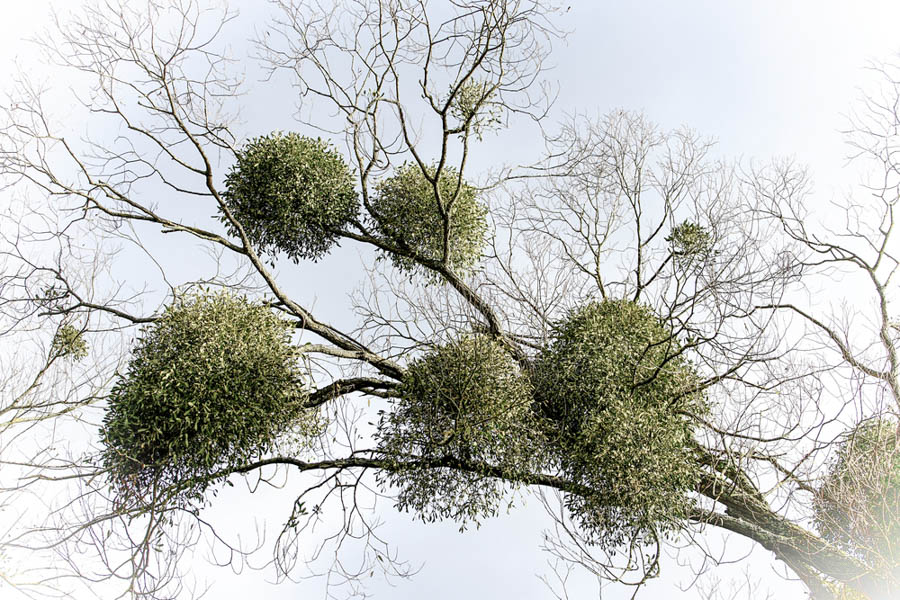A Holiday Kiss Under the…Tree-Killing Parasite?: Mistletoe for The California Holidays, Part 2 of 3

You may know mistletoe as a holiday decoration or a romantic accomplice; but what you don’t know about mistletoe might result in the decline or even death of your landscape trees.
Mistletoe has been a traditional and popular symbol of Christmas for centuries, but its use as a holiday symbol long predates Christianity. Exact origins of most mistletoe legends and traditions are unknown, with folk practices dating back at least to the ancient Norse, Druids, and even the ancient Greeks. Mistletoe has been revered over a span of thousands of years in many cultures, including by modern pagans as well as Christians for its ability not just to remain evergreen, but to bloom and produce fruit (berries) during winter, leading to religious and mystical associations with vitality, love, fertility, rebirth, and resurrection.
If you learn to identify mistletoe, you may be able to ask for holiday kiss under the mistletoe while on a December walk with your date or loved one in your California neighborhood or local park, or even in your own yard. Broadleaf mistletoe (Phoradendron leucarpum spp. macrophyllum) is native to California and is the most widespread species in California. Other native and nonnative species also occur in California.
Unlike ancient peoples who found magic and grandeur in mistletoe, the majority of people today view it almost exclusively as a pest, and a relatively common one on urban California trees. Mistletoe species live in trees as parasites, their specialized roots extending into the living tissues of their hosts. Infestations often start at the tops of trees, especially larger and older trees. Mistletoe may be difficult to spot from the ground and often goes unnoticed because the greenery of mistletoe blends with a tree’s own leaves. Mistletoe becomes easy to spot during winter on deciduous trees after they lose their leaves. It is easier to find on some tree species, such as sycamores, whose leaves are much larger and different in shape than mistletoe, and whose major stems tend to grow with an open habit and more spacing between branches.
If you’ve looked at a tree in midwinter and been surprised to see a single branch or a branch here and there that appears lushly green despite the rest of the tree being bare, and wondered how a deciduous tree could keep leaves on a few branches during winter, you may have found mistletoe. There are also many tree species in California that are semi-deciduous and may partially retain their own leaves throughout winter. Mistletoe grows in a characteristic upright rounded form, with oval leaves, and becomes recognizable once you know what you’re looking for.
How can a seed-producing plant possibly reproduce aboveground in trees? Mistletoe has developed simple and elegant reproductive mechanisms to fill its ecological niche. It produces berries, technically drupes with a small central seed similar to cherries and plums. Mistletoe berries are much loved by various species of birds, and may provide an important food source for birds during winter months. As birds feed, their feces, which contains mistletoe seeds, drops to lower branches. Bird droppings provide natural adhesion – anyone who has scrubbed dried bird droppings from an awning, car, or outdoor furniture can attest to this – and also fertilization for mistletoe seeds, which germinate in place on branches, and extend roots into tree tissues. Birds also spread mistletoe from tree to tree as they nest, roost, rest, and drop feces containing mistletoe seeds into uninfested trees.
Soft, overripe mistletoe berries may also fall and stick to lower branches. For a small portion of seeds that fall and land on lower branches, the viscous fruit may provide lubricant such that seeds slide around to undersides of branches, where seeds adhere as fruit dries, somewhat protected from rain and wind, until conditions allow for germination.
Because seeds are spread by birds and gravity, mistletoe infestations tend to progress from upper branches downward through trees over time. Mistletoe may grow their extensive specialized roots, technically called “haustoria,” in host tissues before showing aerial growth (stems and leaves) that can be seen from the ground.
Mistletoe may weaken or kill individual tree branches, and can be difficult to eradicate as it will usually resprout from roots if the stems and leaves are removed. Trimming infested branches is the best method for control, and for the health and longevity of a tree, is best done as soon as possible after mistletoe plants are noticed or identified. Thinning cuts that remove entire branches are usually recommended as mistletoe roots may extend 12 inches or more down the length of a branch. It usually requires an infestation of numerous individual mistletoe plants over a long period of time to kill a tree. Advice and planning from a professional arborist may be needed to respond effectively to mistletoe infestation, and professional climbers or tree workers may be needed for safe removal of mistletoe.
Don’t know your GardenZeus climate zone? Click here.
This is an updated version of an earlier article published on December 14, 2017.
Other articles with holiday interest:
A Holiday Kiss Under the…Holly?: Mistletoe for The California Holidays, Part 1 of 3
Gifts for Gardeners: Essential and Deluxe Tools for the Home Garden
Poinsettias: Tips, Care and Fun Facts for the Holidays